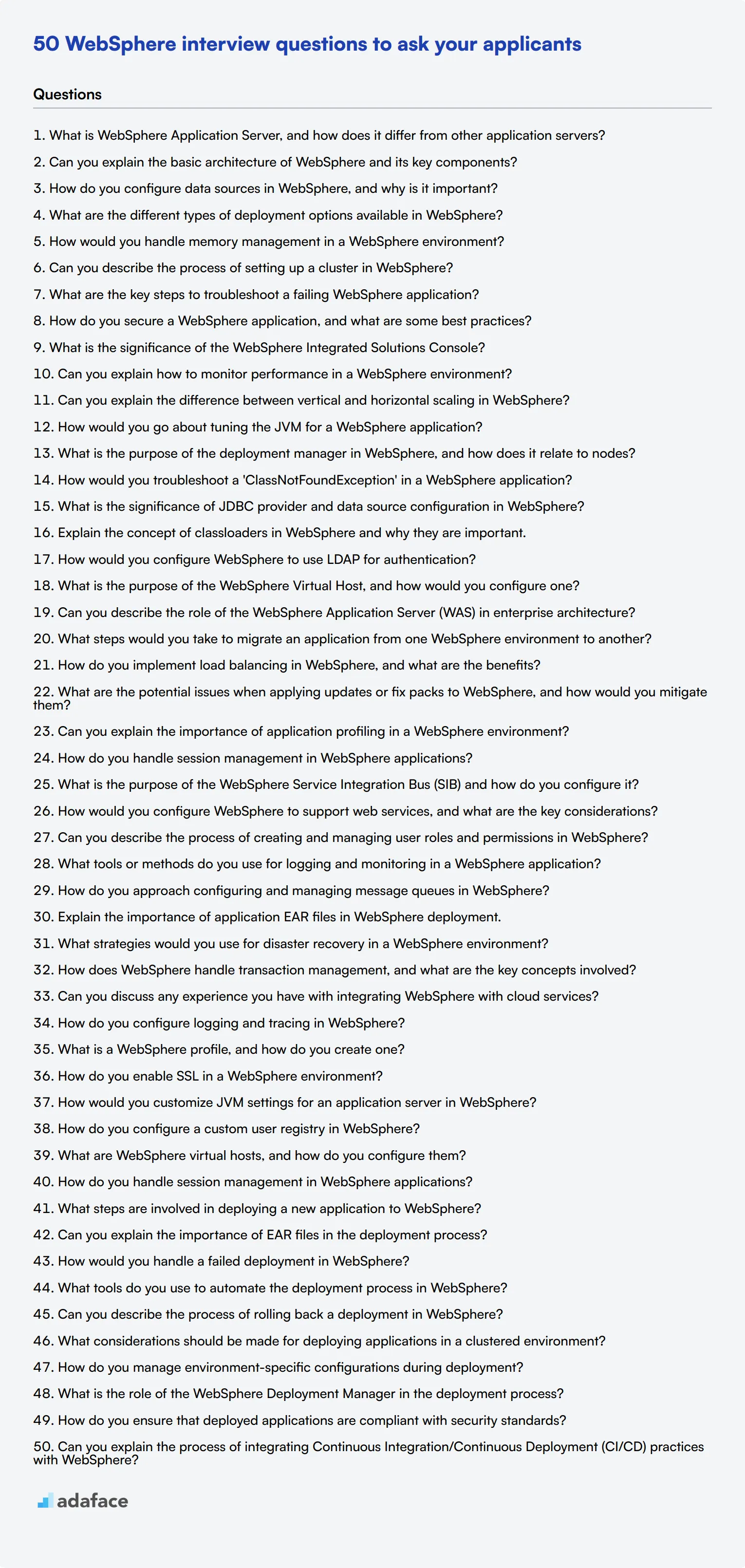Hiring the right WebSphere administrators is crucial for maintaining robust and efficient enterprise applications. Conducting effective interviews allows you to assess candidates' knowledge, experience, and problem-solving skills in WebSphere application server environments.
This blog post provides a comprehensive list of WebSphere interview questions tailored for different experience levels and specific areas of expertise. We've categorized the questions to help you evaluate junior administrators, mid-tier professionals, and assess candidates' understanding of configuration and deployment processes.
By using these questions, you can gain valuable insights into applicants' WebSphere proficiency and make informed hiring decisions. Consider complementing your interview process with a WebSphere skills assessment to thoroughly evaluate candidates' practical abilities before the face-to-face interview.
Table of contents
10 common WebSphere interview questions to ask your applicants
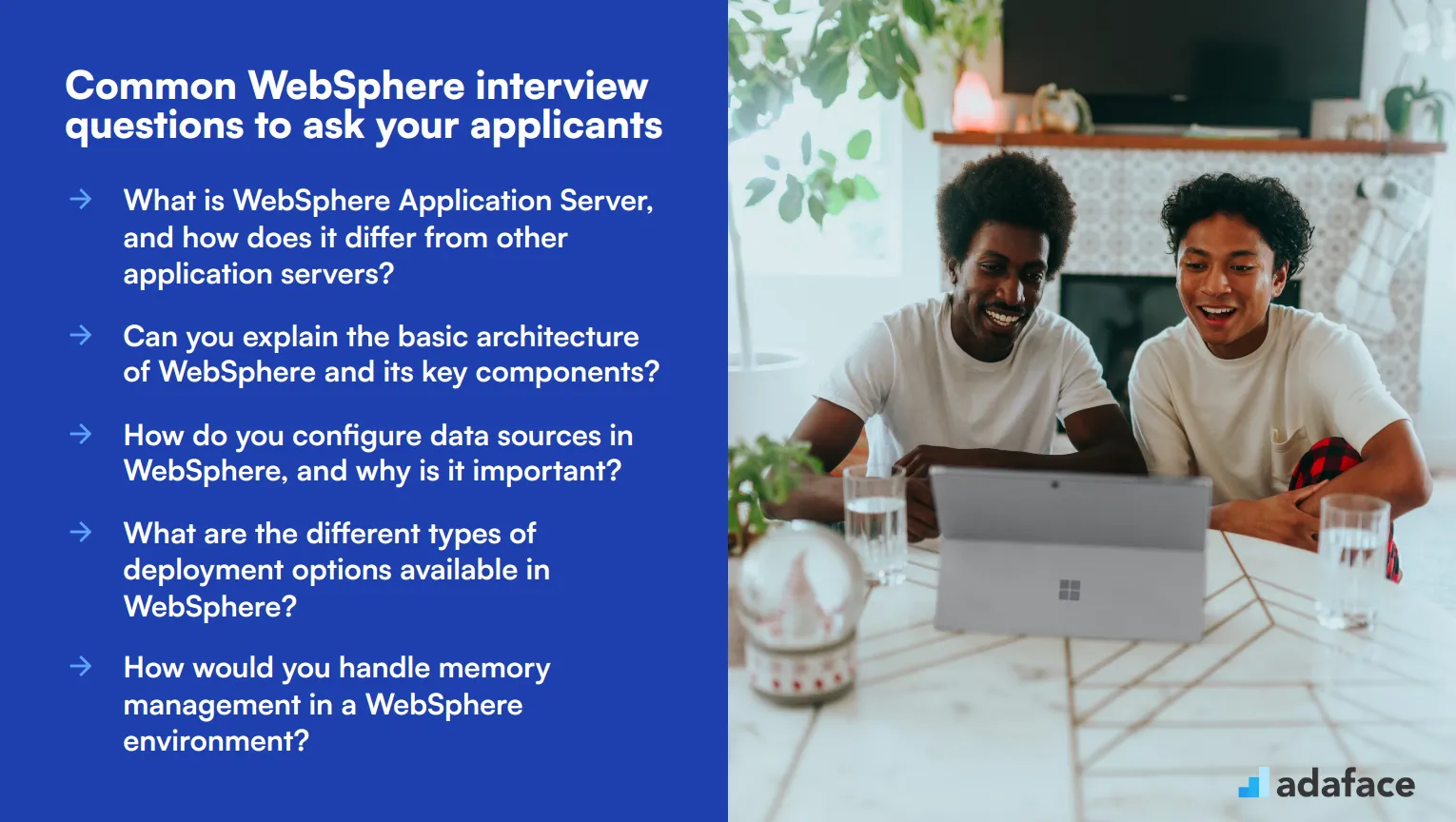
To effectively gauge your applicants' familiarity with WebSphere, consider asking them these targeted interview questions. This list can help you assess their technical proficiency and problem-solving abilities, ensuring they are well-suited for the role. For more tailored job descriptions, check out our Java Developer resources.
- What is WebSphere Application Server, and how does it differ from other application servers?
- Can you explain the basic architecture of WebSphere and its key components?
- How do you configure data sources in WebSphere, and why is it important?
- What are the different types of deployment options available in WebSphere?
- How would you handle memory management in a WebSphere environment?
- Can you describe the process of setting up a cluster in WebSphere?
- What are the key steps to troubleshoot a failing WebSphere application?
- How do you secure a WebSphere application, and what are some best practices?
- What is the significance of the WebSphere Integrated Solutions Console?
- Can you explain how to monitor performance in a WebSphere environment?
8 WebSphere interview questions and answers to evaluate junior administrators
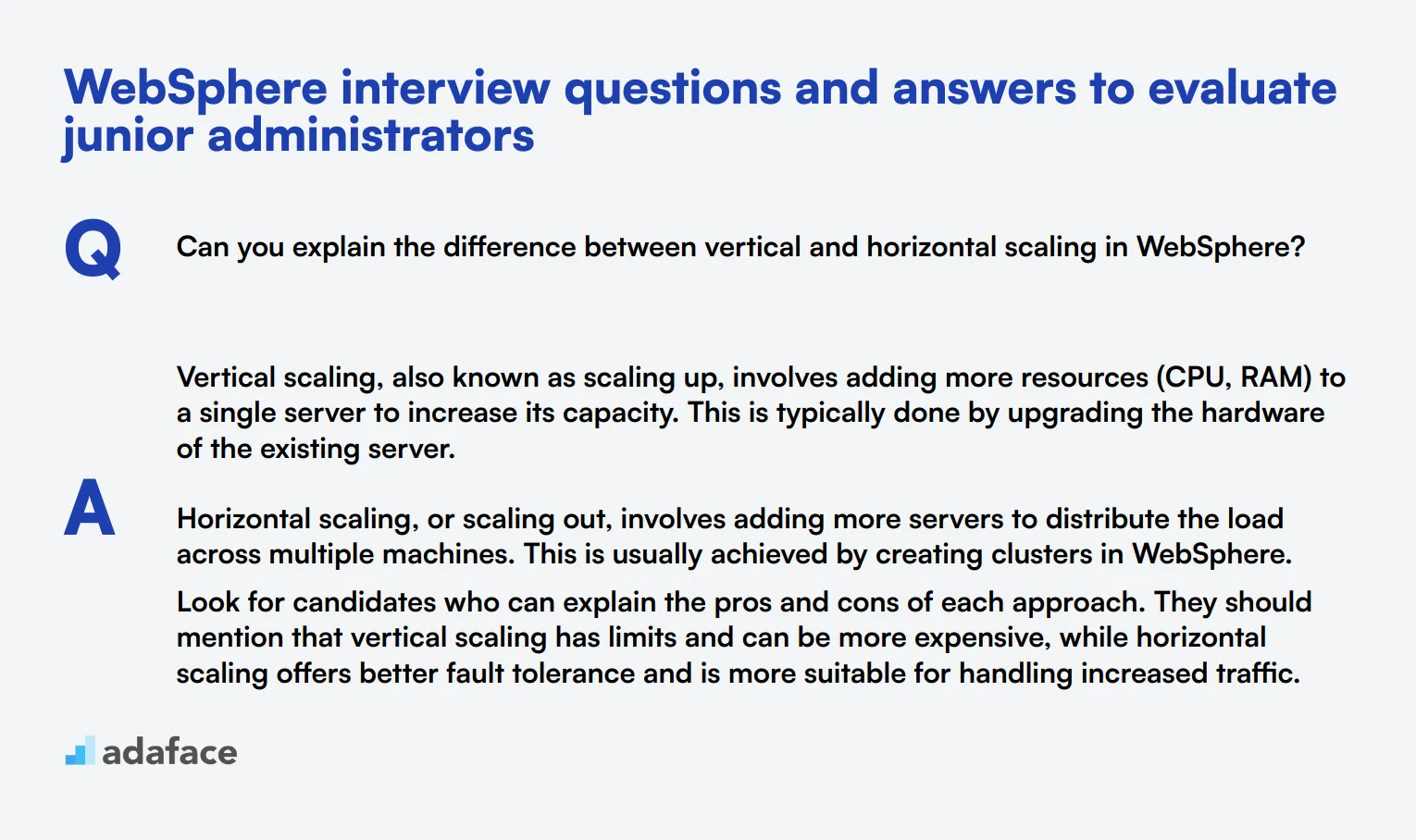
When evaluating junior WebSphere administrators, it's crucial to ask questions that assess their foundational knowledge and practical skills. This curated list of interview questions will help you gauge a candidate's understanding of WebSphere basics and their ability to handle common administrative tasks. Use these questions to identify promising candidates who can grow into more advanced roles within your organization.
1. Can you explain the difference between vertical and horizontal scaling in WebSphere?
Vertical scaling, also known as scaling up, involves adding more resources (CPU, RAM) to a single server to increase its capacity. This is typically done by upgrading the hardware of the existing server.
Horizontal scaling, or scaling out, involves adding more servers to distribute the load across multiple machines. This is usually achieved by creating clusters in WebSphere.
Look for candidates who can explain the pros and cons of each approach. They should mention that vertical scaling has limits and can be more expensive, while horizontal scaling offers better fault tolerance and is more suitable for handling increased traffic.
2. How would you go about tuning the JVM for a WebSphere application?
A good answer should include the following steps:
- Analyze the application's memory usage and performance requirements
- Adjust the heap size settings (initial and maximum)
- Configure garbage collection policies
- Set appropriate JVM arguments for optimized performance
- Use tools like IBM Heap Analyzer or verbose GC logging for monitoring
Strong candidates will emphasize the importance of iterative tuning and monitoring to find the optimal settings for each specific application.
3. What is the purpose of the deployment manager in WebSphere, and how does it relate to nodes?
The deployment manager is a central administrative point in a WebSphere cell. Its primary purposes are:
- Managing configurations for multiple application servers
- Coordinating the deployment of applications across nodes
- Handling security and user management for the cell
- Facilitating centralized monitoring and management
Nodes are managed servers that host applications. They communicate with the deployment manager to receive configuration updates and application deployments.
Look for candidates who can explain the relationship between the deployment manager and nodes, and understand the benefits of this architecture for managing large WebSphere environments.
4. How would you troubleshoot a 'ClassNotFoundException' in a WebSphere application?
A good troubleshooting approach for a 'ClassNotFoundException' should include:
- Check the application's classpath to ensure the missing class is included
- Verify that the required JAR files are present in the WEB-INF/lib directory
- Inspect the server's shared libraries to see if the class should be there
- Review the application's deployment descriptor for any class loading issues
- Use the WebSphere ClassLoader Viewer tool to analyze class loading hierarchy
Strong candidates will mention the importance of understanding WebSphere's class loading hierarchy and the potential for conflicts between application and server libraries. They might also suggest using verbose class loading for more detailed debugging information.
5. What is the significance of JDBC provider and data source configuration in WebSphere?
JDBC providers and data sources are crucial for database connectivity in WebSphere applications. A JDBC provider represents a specific JDBC driver implementation, while a data source is a configuration object that applications use to obtain database connections.
The significance of proper configuration includes:
- Enabling applications to connect to databases without hardcoding connection details
- Allowing for connection pooling, which improves performance and scalability
- Providing a centralized point for managing database connections across multiple applications
- Facilitating easier migration between different database systems
Look for candidates who understand the relationship between JDBC providers and data sources, and can explain how they contribute to efficient database management in a WebSphere environment. They should also be aware of the security implications of storing database credentials in WebSphere configurations.
6. Explain the concept of classloaders in WebSphere and why they are important.
Classloaders in WebSphere are responsible for loading Java classes and interfaces. They follow a hierarchical structure, with each classloader having a parent. The importance of classloaders lies in:
- Providing isolation between applications
- Enabling the loading of different versions of the same class for different applications
- Controlling the visibility and accessibility of classes across the application server
WebSphere uses several types of classloaders, including:
- Bootstrap classloader
- Extension classloader
- Application server classloader
- Web module classloader
- EJB module classloader
Strong candidates should be able to explain the classloader hierarchy and how it affects application behavior. They should also understand common classloading issues and how to resolve them, such as using the correct classloader policy for shared libraries.
7. How would you configure WebSphere to use LDAP for authentication?
Configuring WebSphere to use LDAP for authentication involves several steps:
- Set up a standalone LDAP registry or federated repositories
- Configure the LDAP server details in WebSphere's admin console
- Map LDAP groups to WebSphere roles
- Set up SSL for secure communication with the LDAP server
- Test the configuration with sample user accounts
Candidates should be able to explain the benefits of using LDAP for authentication, such as centralized user management and single sign-on capabilities. They should also be aware of potential challenges, like performance considerations for large user bases and the need for proper LDAP server maintenance.
Look for answers that demonstrate an understanding of security best practices and the ability to integrate WebSphere with enterprise directory services.
8. What is the purpose of the WebSphere Virtual Host, and how would you configure one?
A Virtual Host in WebSphere is a logical grouping of host aliases and port numbers. Its main purposes are:
- Allowing multiple websites or applications to share the same physical server
- Enabling different URL paths for accessing applications
- Facilitating the use of multiple IP addresses or domain names on a single server
To configure a Virtual Host:
- Access the WebSphere Admin Console
- Navigate to the 'Environment' section and select 'Virtual Hosts'
- Create a new Virtual Host or modify an existing one
- Add host aliases (hostname and port combinations)
- Associate the Virtual Host with web modules or enterprise applications
Look for candidates who understand the relationship between Virtual Hosts and web applications, and can explain scenarios where custom Virtual Hosts would be beneficial. They should also be aware of how Virtual Hosts interact with HTTP servers and proxy settings in a production environment.
15 intermediate WebSphere interview questions and answers to ask mid-tier administrators.
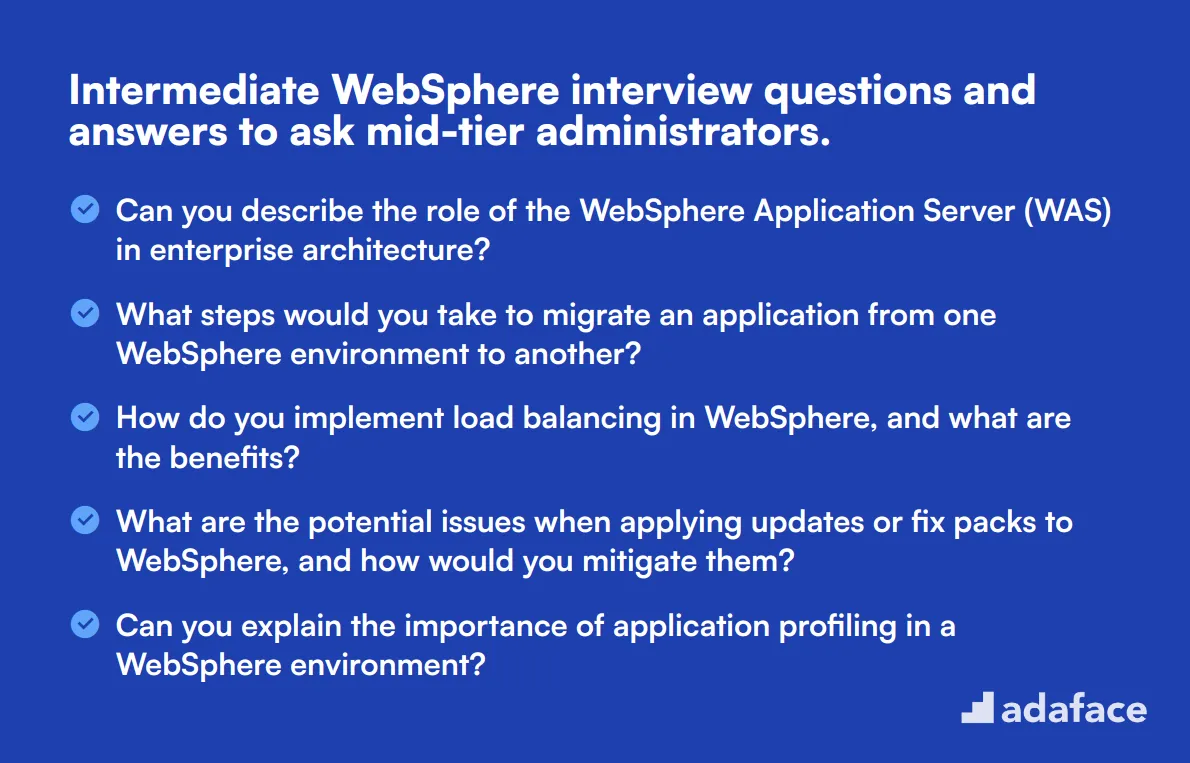
To evaluate whether your candidates possess the necessary skills for mid-tier WebSphere administration, utilize this collection of intermediate interview questions. These inquiries will help you gauge their technical knowledge and practical experience in managing complex WebSphere environments, which is crucial for various software engineer roles.
- Can you describe the role of the WebSphere Application Server (WAS) in enterprise architecture?
- What steps would you take to migrate an application from one WebSphere environment to another?
- How do you implement load balancing in WebSphere, and what are the benefits?
- What are the potential issues when applying updates or fix packs to WebSphere, and how would you mitigate them?
- Can you explain the importance of application profiling in a WebSphere environment?
- How do you handle session management in WebSphere applications?
- What is the purpose of the WebSphere Service Integration Bus (SIB) and how do you configure it?
- How would you configure WebSphere to support web services, and what are the key considerations?
- Can you describe the process of creating and managing user roles and permissions in WebSphere?
- What tools or methods do you use for logging and monitoring in a WebSphere application?
- How do you approach configuring and managing message queues in WebSphere?
- Explain the importance of application EAR files in WebSphere deployment.
- What strategies would you use for disaster recovery in a WebSphere environment?
- How does WebSphere handle transaction management, and what are the key concepts involved?
- Can you discuss any experience you have with integrating WebSphere with cloud services?
7 WebSphere interview questions and answers related to configuration
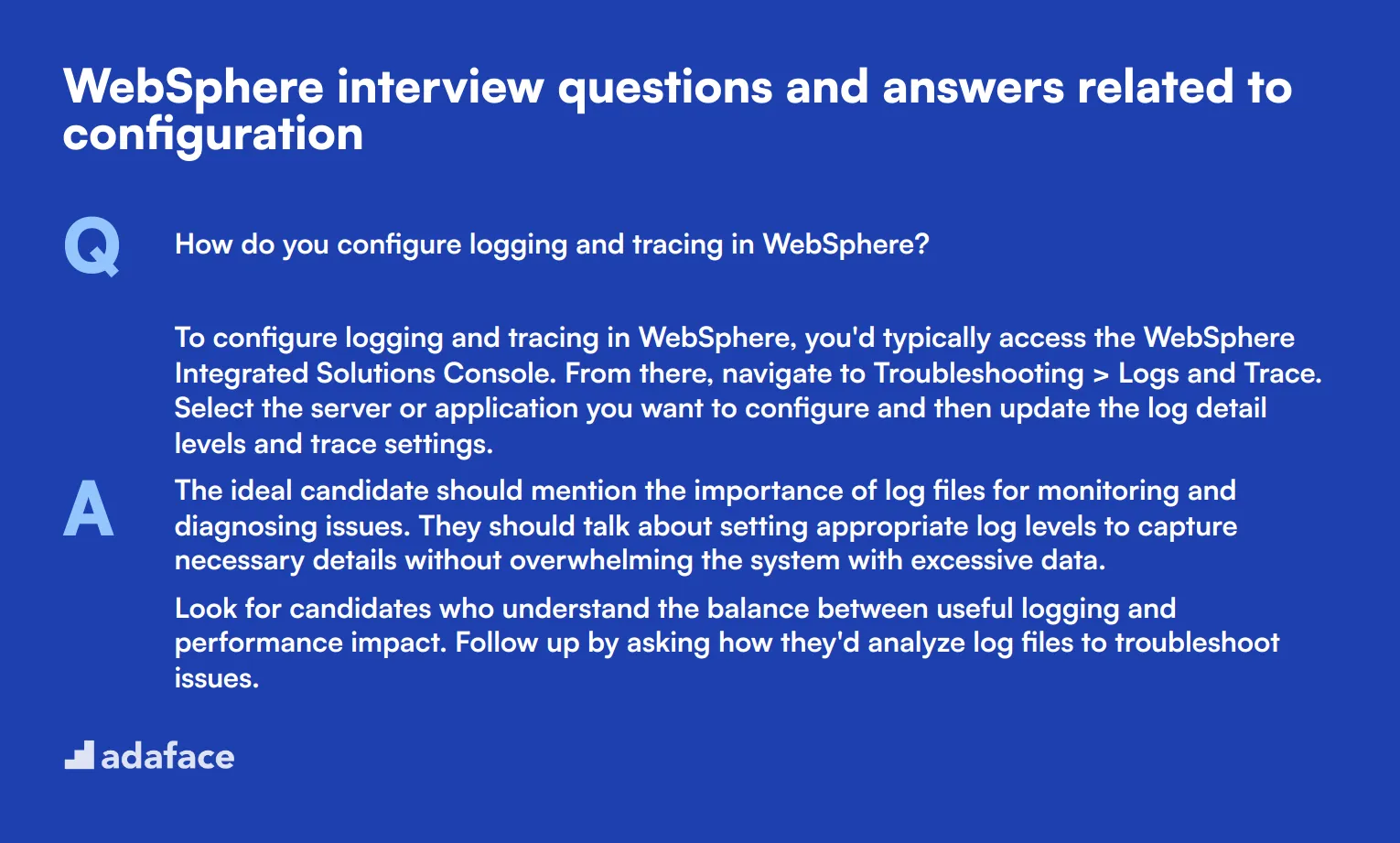
Looking to gauge how well candidates can configure and manage WebSphere environments? This section is designed to help you ask pointed questions to uncover their practical knowledge and ensure they can handle real-world scenarios with ease. Let's dive into some essential WebSphere configuration questions.
1. How do you configure logging and tracing in WebSphere?
To configure logging and tracing in WebSphere, you'd typically access the WebSphere Integrated Solutions Console. From there, navigate to Troubleshooting > Logs and Trace. Select the server or application you want to configure and then update the log detail levels and trace settings.
The ideal candidate should mention the importance of log files for monitoring and diagnosing issues. They should talk about setting appropriate log levels to capture necessary details without overwhelming the system with excessive data.
Look for candidates who understand the balance between useful logging and performance impact. Follow up by asking how they'd analyze log files to troubleshoot issues.
2. What is a WebSphere profile, and how do you create one?
A WebSphere profile is an instance of the WebSphere Application Server environment. It contains configurations and applications specific to that instance. To create a profile, you can use the Profile Management Tool (PMT) or command-line utilities like manageprofiles.sh (or .bat on Windows).
The candidate should explain the types of profiles available, such as application server profiles, custom profiles, and administrative agent profiles. They should also touch on the importance of isolating different environments (development, testing, production) using separate profiles.
An ideal response will include when and why to use different profile types. Follow up by asking how they'd back up and restore profiles to test their understanding of profile management.
3. How do you enable SSL in a WebSphere environment?
Enabling SSL in WebSphere involves configuring SSL settings in the WebSphere Integrated Solutions Console. Navigate to Security > SSL certificate and key management. From there, manage key stores and certificates, configure SSL configurations, and associate them with your endpoints.
Candidates should mention generating or importing certificates and creating SSL configurations. They should also discuss the importance of securing communication channels to protect sensitive data.
Look for responses that demonstrate a clear understanding of SSL certificates, key stores, and the role they play in securing WebSphere applications. A strong candidate will also emphasize testing the SSL setup to ensure it's configured correctly.
4. How would you customize JVM settings for an application server in WebSphere?
Customizing JVM settings in WebSphere is done through the WebSphere Integrated Solutions Console. Navigate to Servers > Server Types > WebSphere application servers, select your server, and click on Java and Process Management > Process Definition > Java Virtual Machine. From here, you can modify settings like initial heap size, maximum heap size, and generic JVM arguments.
Candidates should highlight the importance of tuning JVM settings based on the application's performance requirements and resource availability. They might also mention monitoring tools to assess the impact of these changes.
An ideal response will show a balance between theoretical knowledge and practical experience. Follow up by asking for examples of issues they've resolved through JVM tuning.
5. How do you configure a custom user registry in WebSphere?
To configure a custom user registry in WebSphere, navigate to Security > Global security in the WebSphere Integrated Solutions Console. Under User account repository, select Custom and configure the necessary settings to connect to your user registry.
Candidates should mention configuring the registry details such as the user and group information and implementing any custom logic needed for authentication and authorization.
Look for candidates who can explain the benefits of using a custom user registry, such as improved integration with existing systems. Follow up by asking how they'd troubleshoot access issues related to the user registry.
6. What are WebSphere virtual hosts, and how do you configure them?
WebSphere virtual hosts are configurations that allow multiple domains to be hosted on a single application server instance. To configure virtual hosts, go to Environment > Virtual Hosts in the WebSphere Integrated Solutions Console. Create a new virtual host and specify host aliases to map domain names to the server.
Candidates should explain that virtual hosts simplify domain management and improve resource utilization. They should also discuss configuring host aliases and binding them to specific applications or modules.
An ideal response will showcase an understanding of how virtual hosts enhance flexibility and scalability in a WebSphere environment. Follow up by asking about scenarios where virtual hosts would be particularly useful.
7. How do you handle session management in WebSphere applications?
Session management in WebSphere can be configured via the WebSphere Integrated Solutions Console. Navigate to Servers > Server Types > WebSphere application servers, select your server, and click on Session management under Container Settings. You can configure settings like session persistence, timeout, and cookie properties.
Candidates should discuss the importance of session management for maintaining user state across multiple requests. They might also mention different session persistence options like database persistence and memory-to-memory replication.
Look for candidates who understand the trade-offs between different session management strategies. Follow up by asking how they'd address common session management issues like session hijacking or excessive memory usage.
10 WebSphere questions related to deployment processes

To ensure your candidates possess the necessary skills for effective WebSphere deployment, consider asking these targeted questions. They will help you gauge not only their knowledge but also their practical experience in handling deployment processes. This insightful approach will assist in finding the right fit for roles like a Java Developer.
- What steps are involved in deploying a new application to WebSphere?
- Can you explain the importance of EAR files in the deployment process?
- How would you handle a failed deployment in WebSphere?
- What tools do you use to automate the deployment process in WebSphere?
- Can you describe the process of rolling back a deployment in WebSphere?
- What considerations should be made for deploying applications in a clustered environment?
- How do you manage environment-specific configurations during deployment?
- What is the role of the WebSphere Deployment Manager in the deployment process?
- How do you ensure that deployed applications are compliant with security standards?
- Can you explain the process of integrating Continuous Integration/Continuous Deployment (CI/CD) practices with WebSphere?
Which WebSphere skills should you evaluate during the interview phase?
While it's challenging to assess all aspects of a candidate's WebSphere expertise in a single interview, focusing on core skills can provide valuable insights. The following key areas are particularly important when evaluating WebSphere proficiency.
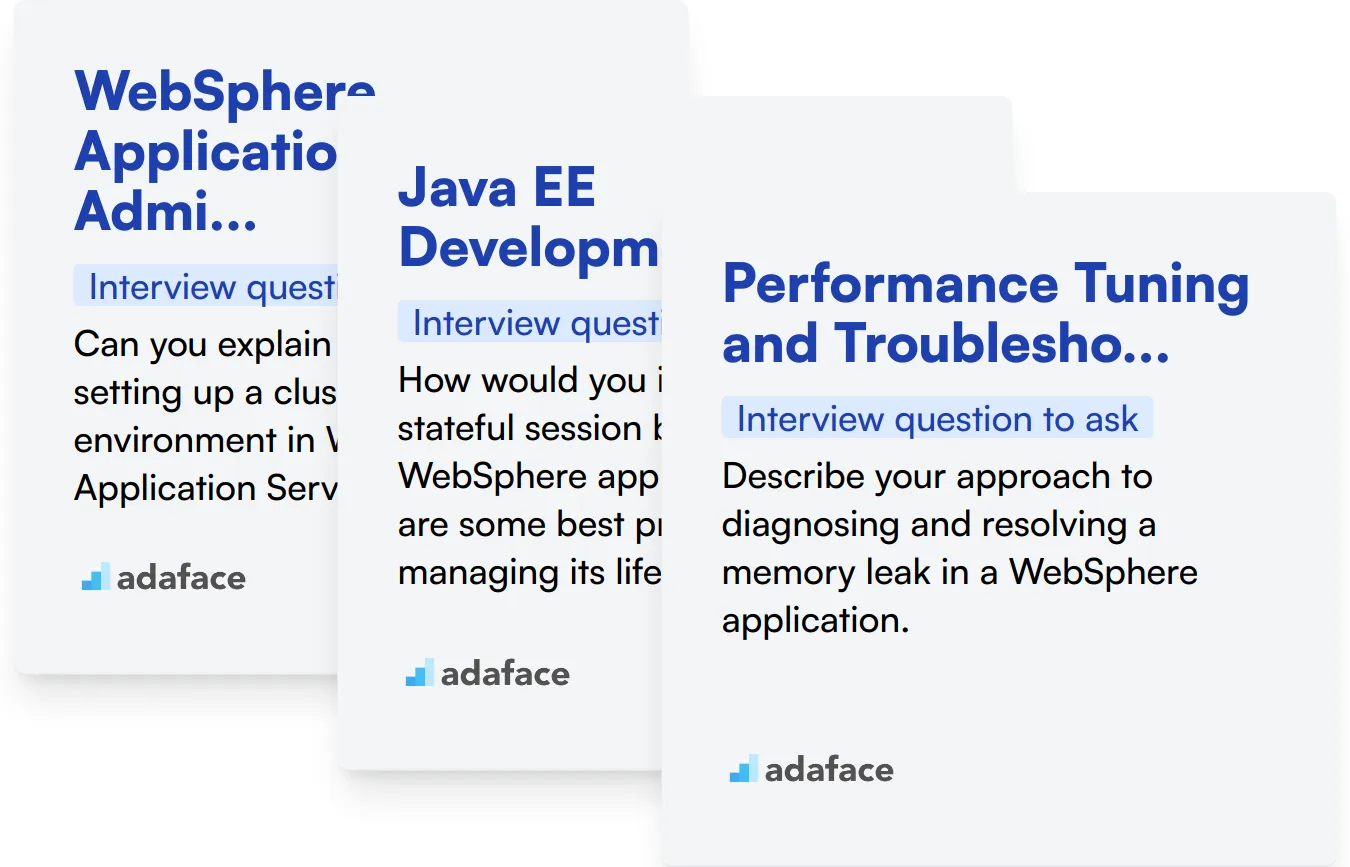
WebSphere Application Server Administration
WebSphere Application Server (WAS) is the cornerstone of IBM's WebSphere software platform. Proficiency in WAS administration is essential for managing and optimizing enterprise Java applications.
To evaluate this skill, consider using an assessment test with relevant multiple-choice questions. This can help filter candidates based on their knowledge of WAS configuration, deployment, and troubleshooting.
During the interview, you can ask targeted questions to gauge the candidate's hands-on experience with WAS administration. Here's an example question:
Can you explain the process of setting up a clustered environment in WebSphere Application Server?
Look for answers that demonstrate understanding of node agents, deployment managers, and cluster configuration. The candidate should be able to outline the steps involved and discuss potential challenges in a clustered setup.
Java EE Development
Strong Java EE skills are fundamental for developing applications on WebSphere. Candidates should be well-versed in Java EE specifications and their implementation within the WebSphere environment.
Consider using a Java assessment test to evaluate the candidate's Java EE proficiency. This can help identify those with a solid foundation in enterprise Java development.
To assess Java EE skills specific to WebSphere, you might ask:
How would you implement a stateful session bean in a WebSphere application, and what are some best practices for managing its lifecycle?
Listen for explanations that cover EJB annotations, transaction management, and state maintenance. The candidate should also mention considerations for clustering and failover in a WebSphere environment.
Performance Tuning and Troubleshooting
Optimizing WebSphere application performance and resolving issues quickly are critical skills. Candidates should demonstrate knowledge of performance tuning techniques and troubleshooting methodologies specific to WebSphere.
To assess these skills, you might ask a question like:
Describe your approach to diagnosing and resolving a memory leak in a WebSphere application.
Look for answers that mention using tools like IBM Heap Analyzer, analyzing heap dumps, and reviewing application code. The candidate should also discuss preventive measures and best practices for memory management in WebSphere applications.
Hiring the best WebSphere candidates with Adaface
If you are looking to hire someone with WebSphere skills, you need to ensure they have those skills accurately.
The best way to do this is to use skill tests. Consider using our IBM WebSphere Online Test for precise evaluation.
Once you use this test, you can shortlist the best applicants and call them for interviews.
For the next steps, visit our sign-up page or explore our test library to get started.
IBM WebSphere Online Test
Download WebSphere interview questions template in multiple formats
WebSphere Interview Questions FAQs
Common questions include topics on WebSphere administration, configuration, and deployment processes.
Ask questions related to basic administration tasks and their understanding of WebSphere components.
Focus on intermediate level questions assessing their problem-solving skills, and understanding of WebSphere architecture.
Ask about their experience with configuration files, tuning server settings, and managing resources.
Understanding the deployment process ensures the candidate can manage application updates and rollbacks efficiently.
Adaface provides tailored assessments and interview questions to find the best WebSphere talent for your team.

40 min skill tests.
No trick questions.
Accurate shortlisting.
We make it easy for you to find the best candidates in your pipeline with a 40 min skills test.
Try for freeRelated posts
Free resources




